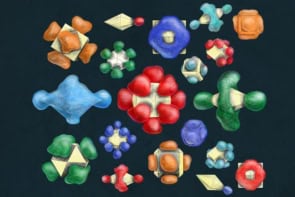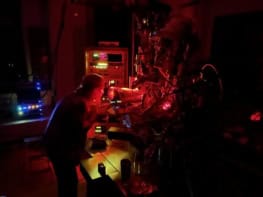A gadget that boosts a laser signal by a factor of 60 - based on the transfer of photons rather than electrons - could seed a new generation of ultrafast components for optical circuits. Junji Tominaga of the National Institute of Advanced Industrial Science in Japan and colleagues developed the device, which paves the way for all-optical circuits that transmit information at - literally - the speed of light. (J Tominaga et al 2001 Appl. Phys. Lett. 78 2417). The new 'photonic transistor' would be just nanometres thick, unlike existing devices that rely on long optical fibres to produce the gain.
Optical signals in conventional optoelectronic devices have to be converted into electronic signals when they are amplified or manipulated. But the slow pace of electrons through silicon-based components significantly reduces the overall efficiency of conventional devices. The photonic transistor created by Tominaga’s group amplifies a blue laser signal without converting it into an electronic signal, and so bypasses this step.
Tominaga’s team etched a series of pits into a track of a rotating optical disk. A layer of silver oxide coats the pitted substrate, which is then overlaid with a dielectric layer. Red and blue lasers focus at the same spot on the rotating disk. The red laser breaks up tiny patches of the silver oxide layer to create nanometre-sized grains of silver, which act as light-scattering centres. The blue laser – the signal to be amplified – creates localized pools of excited electrons called plasmons around the pits in the disk.
If a silver cluster forms above a pit in the base layer – and therefore above a localized plasmon – the blue laser signal scatters from the silver grain and releases the energy from the plasmon below. This process amplifies the blue laser signal by up to a factor of 60. “We do not fully understand the plasmon interaction”, Tominaga admits, “but it is a very interesting field of research for the future”.
Crucially, the silver atoms in the grains then re-integrate into the silver oxide layer because they are so tightly sandwiched in the layered structure. The silver clusters are therefore equivalent to the ‘gate’ that controls the gain in a conventional transistor. “This is a completely new concept”, says Tominaga.
The level of amplification in the device is tuned by adjusting the power of the red laser. This affects the size of the silver grains formed. This in turn controls the strength of the blue laser signal because larger grains scatter more blue laser light.
“The increase of a factor of 60 is our first attempt”, says Tominaga. “By optimising the structure we believe we can achieve a gain of 109 under certain conditions”. Tominaga and co-workers are also optimistic that techniques used to manufacture conventional electronics devices can be adapted to mass-produce their photonic transistor.



